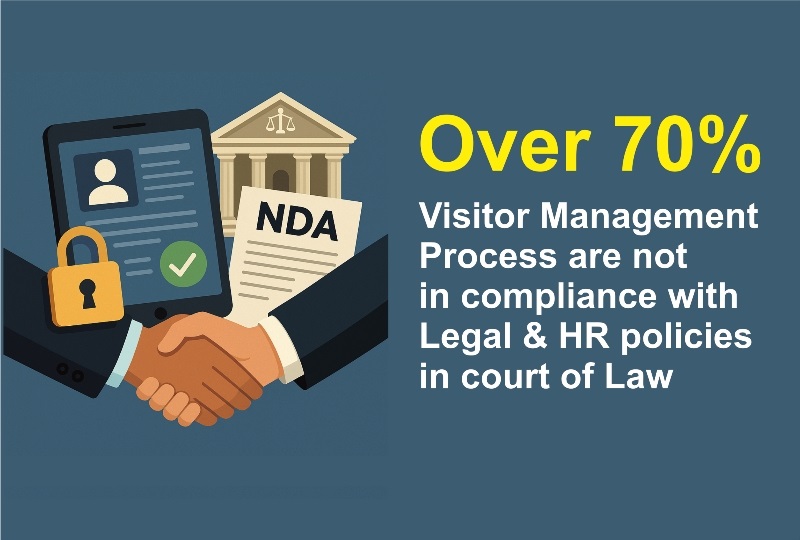Fortify Your Legal Position with Digital Visitor Management
Published on 5/24/2025 • Updated on 7/4/2025

In today’s litigious business environment, relying on pen-and-paper visitor logs simply won’t stand up in court. A handwritten register offers no enforceable agreement, no secure audit trail, and no proof that your proprietary processes were protected. Without a legally binding acknowledgement such as a digitally captured Terms & Conditions or non-disclosure agreement (NDA) you expose your organization to intellectual property theft, unauthorized disclosures, and significant compliance risk.
1. Enforceable Digital Agreements
Under the U.S. ESIGN Act and the Uniform Electronic Transactions Act (UETA), electronic signatures hold the same weight as handwritten ones. A modern Visitor Management System (VMS) like VisitorFlow can present your company’s Terms & Conditions or site-specific NDA at check-in and require each visitor’s e-signature. This creates a tamper-evident record that a court will accept as proof the visitor agreed to confidentiality obligations before entry something a paper logbook can never guarantee.
2. Comprehensive Audit Trails
In any legal dispute whether alleging breach of contract, misappropriation of trade secrets, or negligence your strongest defense is an unbroken chain of evidence. Digital VMS platforms automatically timestamp every action: pre-registration, badge printing, photo capture, and agreement acceptance. Those encrypted logs, stored in secure servers or compliant cloud environments, establish exactly when and how each visitor accessed your facility, and under what conditions.
3. Stronger Protection of Trade Secrets
Manual processes allow visitors to photograph or observe sensitive operations without accountability. If a visitor later shares proprietary designs or process details, proving the breach is uphill work. Digital solutions lock down this risk by:
-
Capturing high-resolution ID scans and facial images to verify identity
-
Printing badges with embedded barcodes or RFID to restrict access to sensitive zones
-
Recording which areas were accessed and how long the visitor stayed
These measures not only deter bad actors but also provide compelling evidence in any intellectual property lawsuit.
4. Efficient Incident Response
Should an incident occur unauthorized disclosure, workplace accident, or security breach your legal team needs immediate, accurate information. A digital VMS Software delivers real-time visitors headcounts and location logs, so you can demonstrate compliance with safety regulations (e.g., OSHA’s site-access requirements) and accelerate internal investigations. By contrast, hunting for a misplaced ledger or deciphering illegible entries could delay response and weaken your legal position.
5. Data Privacy and Regulatory Compliance
Beyond corporate liability, data protection laws such as GDPR, HIPAA, or India’s Digital Personal Data Protection Act require clear consent and secure handling of personal information. Paper logs expose visitor data names, contact details, arrival/departure times to anyone who flips through the register. Digital VMS solutions encrypt that data, enforce retention policies (e.g., automatic deletion after 30 days), and record consent in compliance with privacy statutes. These controls shield you from potential fines and class-action suits.
6. Scalability and Consistency
Whether you operate a single facility or a global network of sites, a digital VMS ensures consistent legal safeguards across every location. Standardized workflows guarantee that each visitor encounters the same binding agreements and security checks, eliminating the variability and human error inherent in manual processes.
Conclusion
In sum, Digital Visitor Management is not merely a convenience it is a critical legal instrument. By digitizing visitor agreements, enforcing robust audit trails, and protecting sensitive information at every touch point, you transform an ordinary check-in process into a first line of defense against contractual, intellectual property, and regulatory risks. With VisitorFlow, you gain the documentation and controls necessary to prove, beyond dispute, that your organization upheld its legal and compliance obligations.
- What Is Courier Management Software and Why Your Office Needs It
- Cloud-Based QR Code Visitor Management Outperforms Paper Registers and Static Desktop Software
- DPDP-Compliant Visitor Onboarding: What Security & HR Must Capture at the Gate
- Transforming Visitor Gate Passes into Legally Enforceable Visitor Experiences
- Visitor Lanyards vs. Visitor Stickers: Why It’s Time to Make the Switch
- Why use Material Gate Pass Software to Manage material Movement
- Case Study Video : Incident reporting & management software
- How QR Code-Based Incident Reporting Transforms Manufacturing Operations
- Transforming Visitor Management: Ensuring Legal Compliance and IP Protection with Cloud-Based Software
- Step-by-Step Guide to Visitor Management in Manufacturing Factories